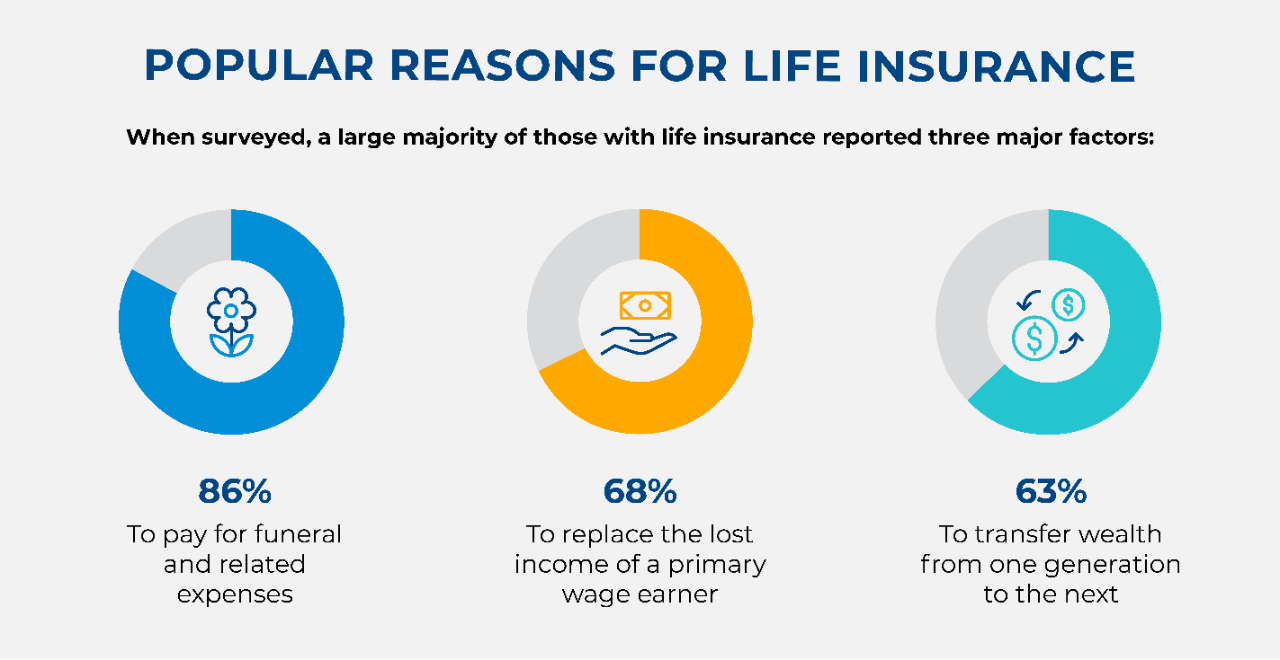This website or its third-party tools use cookies, which are necessary to its functioning and are required to achieve the purposes illustrated in our online privacy policy.
These key factors can help you figure out your life insurance sweet spot.

When it comes to life insurance, almost everyone has the same question: How much do I need? While there’s no one-size-fits-all answer, there are some key factors that can help you determine what’s right for you and your family.
Most people overestimate how much life insurance costs and underestimate how much they need. This causes many people to be underinsured. Seven in 10 American consumers say they personally need more life insurance, according to the Life Insurance Marketing and Research Association (LIMRA). Many don’t have insurance at all, and among those who do, one in four only have employer-sponsored coverage, which is vulnerable to job changes. LIMRA estimates that even among the insured, 25 million Americans need more coverage.1
Most insured Americans (61%) report policies worth $100,000 or less (or were unsure of their coverage amount), according to MoneyGeek’s 2022 life insurance survey2. For many, this coverage falls far short of needs. In the U.S., the median salary is nearly $57,200, according the U.S. Bureau of Labor Statistics3. At that salary, a payout of less than $100,000 would cover less than two years of income replacement. By comparison, according to a general rule-of-thumb in the life insurance industry, life insurance should ideally cover ten times salary, plus some extra, such as $100,000 for each child.
To avoid a shortfall and get the amount of life insurance that’s right for your family, it’s important to understand your unique needs and situation.
What do I need life insurance for?
Life insurance helps provide security in a variety of situations, and it can help keep your family’s long-term goals on track for whatever happens.
- Almost half of American households (44%) would face significant financial difficulties if they lost the family’s primary wage earner, according to surveys by LIMRA4.
- More than a quarter (28%) of families would encounter serious financial trouble within the first month, LIMRA reports4.
For small business owners, it can help ensure the company’s continuity during times of transition.
 Source: Life Insurance Marketing and Research Association (LIMRA)¹
Source: Life Insurance Marketing and Research Association (LIMRA)¹
How can I figure out the amount of life insurance I need?
To determine how much life insurance you need, start by calculating the financial obligations that you want to cover. This list can include a variety of commitments and goals that are unique to your situation. Some experts simplify this as the DIME method, which stands for debt, income, mortgage and education.
- Debt: Do you have outstanding non-mortgage debts that your family would be responsible for? This can include car loans, credit card debt and other large debts you may owe. It’s also worth noting funeral expenses, which can become an instant debt if not accounted for.
- Income Replacement: Do your loved ones rely on your ongoing income to maintain their current lifestyle? If so, you may want to consider a life insurance policy that includes some years of income replacement (how many years depends on the age of your children and other factors). Ultimately, it’s up to you to decide.
- Mortgage: Do you have a balance on your mortgage? Having life insurance pay off what you owe can help ensure that your family is able to stay in the same home.
- Education Spending: Do you have children or grandchildren who may someday attend college? If so, you may want to include future college costs in your calculations.
Once you’ve added up your DIME financial obligations, subtract any savings or assets that could be used for any of the above expenses. The resulting number is probably close to the right amount of life insurance coverage for you. This life insurance calculator from Pacific Life can help you get started. Work with a life insurance producer to help you with your unique financial goals.
READ MORE

Retirement Planning
Talking Social Security With Mary Beth Franklin
Staying aware of current regulations set by the Social Security Administration can help retirees receive the full benefits they deserve.

Retirement Planning / Family
How Annuities Can Boost Your Retirement Savings
The tax-deferred growth potential of an annuity can boost your savings for the future.

Retirement Planning / Family
How to Enhance Your Retirement Strategy with Cash Value Life Insurance
Your retirement strategy should begin with a tax-advantaged retirement account, but it doesn't have to end there. Supplementing your 401(k) or IRA with cash value life insurance can help give you greater financial flexibility during your lifetime while providing protection to your loved ones.

Family / Estate Planning
What Blended Families Should Know About Estate Planning
An estate plan with an Irrevocable Life Insurance Trust may help reduce estate taxes and ensure equitable distribution of a blended family’s assets.

Family / Estate Planning
Ensuring a Smooth Transition for Your Family Business
A plan that includes life insurance can help provide liquidity and equality in a family business succession.

Home / Estate Planning
How to Help Protect Your Estate Plan from an Uncertain Future
A life insurance trust can help provide flexibility and protection for the future.

Family / Estate Planning
Estate Planning for Unmarried Couples
Life insurance can help maximize wealth transfer for unmarried couples.

Family / Estate Planning
5 Ways Life Insurance Can Help With Estate Planning
As you develop or update an estate plan, considering the following ways life insurance can help address your needs.

Career And Business
Retirement Savings Options at a New Job
Weigh your choices before deciding where—or whether—to move your retirement savings when you switch employers.

Retirement Planning
Ways to Retire Confidently
If you’re concerned about saving enough for retirement, a protected source of income can help put your mind at ease.

Retirement Planning / Home
Don’t Put Off Saving for Retirement
Start building your nest egg early to prepare for the unexpected.

Retirement Planning / Family
Managing Your Beneficiaries’ Inheritance
An annuity with a predetermined beneficiary payout option can offer greater control without a trust.

Retirement Planning
How to Save on Charitable Giving During Retirement
Qualified charitable distributions can help with tax savings and at the same time give to charity during retirement.

Retirement Planning
Picking the Right Type of IRA for You
Understanding the difference between a traditional and Roth IRA can go a long way in planning your retirement savings strategy.

Estate Planning / Family
How to Cope Without the Family Breadwinner
Take these steps to help your loved ones prepare financially in the event the worst happens to you.

Career And Business / Family
A Smart Way for Philanthropists to Give More
A well-designed charitable remainder trust can help lower taxes and aid in financial planning.

Retirement Planning
The Challenges of Living Longer
The good news: Retirees are living longer. The bad news: That may mean retirees will have to fund more years of retirement.

Retirement Planning
Make the Most of Your Retirement With an Informed Income Strategy
Annuities offer another way to put a floor under your retirement income, providing an retirement income stream in exchange for an initial investment. Immediate annuities begin issuing payments soon after you make your investment, while deferred annuities are invested for a period of time before you start taking withdrawals. You can also choose between fixed (-rate) and variable annuities. Fixed annuities earn a guaranteed interest rate over time, while variable annuities are tied to the performance of an investment portfolio. Both provide monthly income for life and protection for your loved ones through a death benefit.

Estate Planning / Family
Finding a Way to Hand Over a Family Business
Creating a detailed succession plan is paramount for a smooth and profitable transition.

Family / Retirement Planning
Balancing the Care of Aging Parents and Children
There are ways to ease the burden of this high-stress juggling act.

Retirement Planning
Deciding When to Claim Retirement Benefits
Keys to Optimizing Social Security Income.

Home
How Tax Reform Impacts Retirement and Estate Planning
The new tax law will alter many decisions you may have to make when filing your 2018 taxes.

Retirement Planning
The Importance of Investment Diversification
Methodically placing assets in several baskets isn’t as thrilling, but helps you invest responsibly.

Estate Planning / Family
Protect Your Loved Ones With an Estate Plan
Taking a proactive approach to passing on your assets can help bring peace of mind to you and your family.

Retirement Planning / Home
Choosing a Financial Professional
When searching for the right financial professional for you, start with these 7 questions.

Retirement Planning / Family
Four Ways to Access the Value of a Life Insurance Policy
Life insurance isn’t only for your survivors: Find out how to use its cash value during your lifetime.

Retirement Planning
Women & Finances: Securing Your Retirement
Strategies to help make sure your retirement savings last for life.

Retirement Planning / Family
Women & Finances: Strengthening Your Finances After Divorce
Make sure your retirement plan is still on track.

Family / Home
Women & Finances: Moving Beyond the Loss
The loss of a significant other can offer an opportunity to learn about financial empowerment.

Retirement Planning
Weathering a Turbulent Market
Worried investors would do well to remember that historically, markets recover after a downturn.

Family / Home
The Surprising Affordability of Term Life Insurance
A life insurance policy isn’t as expensive as you think.

Family / Home
Get the Most Out of Your Annual Financial Check-Up
A yearly financial review is a good way to stay fiscally healthy.

Retirement Planning / Family
How to Buy an Annuity
Choose the right annuity plan that aligns with your financial goals.

Family / Home
6 Life Insurance Myths Debunked
Don’t let these common misconceptions prevent you from giving your family the protection they deserve.

Healthcare / Family
Planning for the Cost of Healthcare in Retirement
Trying to anticipate what you’ll spend on healthcare in retirement can seem daunting, but estimates can help you start preparing for the future.

Family / Home
The Benefits of Rethinking Work-Life Balance Before Retirement
Achieving better work-life balance now can help position you for a more fulfilling future.

Family / Estate Planning
How to Buy Life Insurance
These four steps can help you choose the best protection for you and your family.

Retirement Planning / Family
How to Lower Your Taxes in Retirement
You’ve worked hard to build your retirement savings. Now, make sure your money lasts by considering strategies to lower taxes.

Home / Family
The Importance of Financial Literacy
Learn about basic concepts regarding financial literacy: budgeting, saving, debt/spending, and financial management.

Retirement Planning / Family
Make the Most of Your Money with a Financial Plan
A financial plan can help you meet your needs today and reach your long-term goals.

Family / Home
Money Moves to Help You Feel More Confident
Build a stronger financial foundation with these four steps.

Family / Home
Supporting Multiple Generations
Tips for families with many generations living together so everyone stays financially healthy.

Family / Estate Planning
Securing Your Family’s Future
Having an estate plan is essential to maintaining your family’s financial security.

Retirement Planning / Family
4 Ways to Help Turn Income Into Wealth
Build your wealth by incorporating these strategies into your financial plan.

Career And Business
Why Employee Benefits Matter
The key to attracting top talent goes beyond trendy perks.

Retirement Planning / Family
How Much Life Insurance Do I Need?
These key factors can help you figure out your life insurance sweet spot.
Sources:
1 Life Insurance Marketing and Research Association (LIMRA), 2021 Insurance Barometer Study, accessed July 2023
2 MoneyGeek’s 2022 life insurance survey, accessed July 2023
3 U.S. Bureau of Labor Statistics, USUAL WEEKLY EARNINGS OF WAGE AND SALARY WORKERS SECOND QUARTER 2023, accessed July 2023
4 Life Insurance Marketing and Research Association (LIMRA), Why Life Insurance coverage is more important than ever, published February 2021, accessed July 2023
Pacific Life refers to Pacific Life Insurance Company and its affiliates, including Pacific Life & Annuity Company. Insurance products can be issued in all states, except New York, by Pacific Life Insurance Company or Pacific Life & Annuity Company. In New York, insurance products are only issued by Pacific Life & Annuity Company. Product/material availability and features may vary by state. Each insurance company is solely responsible for the financial obligations accruing under the products it issues. Insurance products and their guarantees, including optional benefits and any fixed subaccount crediting rates, are backed by the financial strength and claims-paying ability of the issuing insurance company. Look to the strength of the life insurance company with regard to such guarantees as these guarantees are not backed by the broker-dealer, insurance agency or their affiliates from which this product is purchased. Neither these entities nor their representatives make any representation or assurance regarding the claims-paying ability of the life insurance company.
Pacific Life, its affiliates, their distributors and respective representatives do not provide tax, accounting or legal advice. Any taxpayer should seek advice based on the taxpayer’s particular circumstances from an independent tax advisor or attorney.
The home office for Pacific Life & Annuity Company is located in Phoenix, Arizona. The home office for Pacific Life Insurance Company is located in Omaha, Nebraska.
PL72
